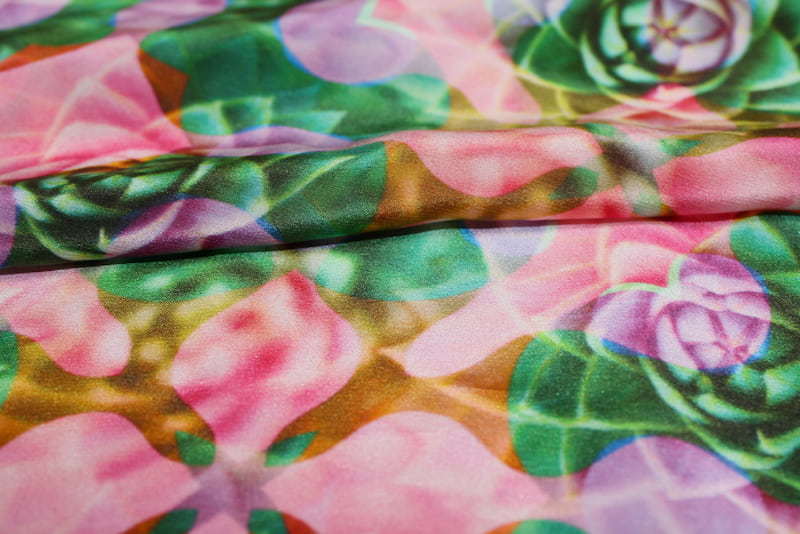So, what’s the difference between satin and silk? What are the pros and cons of both fabrics? And which material is best suited for your project?
What is silk?
Silk is a natural fiber, derived from the cocoons of silkworms. As an organic product, silk has a lot of the same benefits other organic fibers carry with them — for example, silk is very breathable, moisture absorbent, and antibacterial. Additionally, silk has intrinsic properties that give it its characteristic look and feel. Silk tends to be very smooth and shiny, and simultaneously strong and elastic.
Perhaps most importantly, silk is an isothermal fabric, similar to linen. In short, this means that in colder temperatures, silk will help your body to retain heat. But, at the same time, it’ll allow heat to evaporate in warmer weather.
So, there are many pros when it comes to using silk; however, there are also a few downsides. You might wonder, as many do, is silk expensive? And yes, to be honest, silk is more expansive than most other fabric options out there. That is because of the unique way it’s harvested. The price doesn´t make it a very cost-effective option.
Additionally, silk is often considered more sustainable than most fabrics, because it’s made of natural fibers. However, the harvesting of silkworm cocoons often kills the developing pupa, making silk one of the least animal-friendly fabrics on the market.
Silk also isn’t suitable for machine washing. Read all about the maintenance routine for silk in How to wash silk. Just know: in any case, silk requires handwashing.
What is satin?
Satin isn’t a material but rather a specific weaving technique wherein threads of a fabric are woven very closely together. This particular way of weaving creates a supple, shiny look similar to silk. However, it carries different properties because it’s made of another material.
Is satin a natural fabric? That’s a difficult question to answer because you can make any fiber into a satin fabric, if it’s woven using the satin-weaving method. For example, some of the most popular satins are cotton satin, polyester satin, or a satin mix using different fibers.
There are even combinations of silk and satin fabrics out there: like our silk satin fabric.
.jpg)
Fabric type: Silk Satin 19 m/m
The pros and cons of satin
You might wonder, does satin feel like silk? Well, satin and silk have a similar look and feel: both are shiny, smooth, and supple. Additionally, they both look very luxurious and feel nice on the skin. The difference between silk and satin fabric is about which fibers are used to create a satin fabric.
It can sometimes be difficult to determine what type of fiber was used to create a satin, but it’s very relevant for a fabric’s properties. That’s why House of U always lists the materials used on our product pages.
Cotton satin fabrics are a lot more moisture-absorbent than polyester satin fabrics. On the other hand, cotton satin is more sensitive to wrinkles than polyester satin. Satin can also be machine-washed and generally requires a lot less intensive upkeep when it comes to maintenance.
The most significant downsides of using satin are that it isn’t a very durable material and tends to snag and pile, creating ripples in the fabric. Additionally, most satin fabrics tend to be made from polyester or nylon, which results in materials that aren’t very breathable.

Fabric type: Cotton Satin Deco
Silk vs. satin for your project?
Are you working on a new design, and are you wondering whether you should use silk or satin? This depends on what type of project you’re working on and what properties you’d like your fabric to have.
Is your final product a gorgeous dress or blouse that’ll allow you to dance all night without breaking a sweat? Then silk is probably the fabric that’s best suited to your purposes.
Are you designing something with bedding in mind? Satin vs. silk sheets are very similar, but cotton satin is probably the best option. This satin fabric feels soft on the skin, absorbs moisture, and is a lot more affordable than silk.
What about satin vs. silk pillowcases? The rule of thumb for cotton satin bedding still applies, but both silk and satin pillowcases are good for your skin and hair because of the smooth texture of both fabrics. The same goes for a silk or satin nightcap.

Fabric type: Silk Crepe de Chine 10 m/m
Buying silk or satin
So, now that you know the difference in silk and satin, would you like to print your design on a satin or silk fabric? You can easily order custom fabrics online using our store. Upload your design to our design generator, then choose our print on silk or custom satin fabric printing options, and we’ll do the rest for you.
Do you have any questions about our fabrics? Or would you like to get to know more about the way we work? Feel free to contact us — we’re happy to help!


